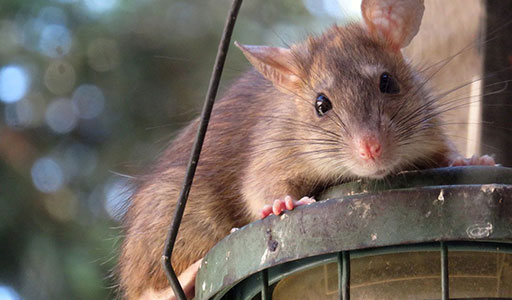Florida is renowned for its temperate climate, one that allows people to wear shorts and flip-flops year-round. Unfortunately, this famous climate is equally appealing to pests. Palm rats also called roof rats or citrus rats are but one pest that thrives in the sunshine state. While Norway rats are by far the most common rat in other parts of the US, in Florida, they are quite rare in comparison to the palm rat.
What Does a Palm Rat Look Like?
Palm rats have scraggly, coarse fur that is often black or dark brown. Their hairless, scaly tails are longer than their body and head combined. Adults are 12-14 inches long and weigh 5-10 ounces. Like most rats, palm rats are omnivores, but they have a strong taste for citrus fruits and nuts. These rodents are nocturnal, climbing fruit trees at night to feed. They are active all throughout the year.

Do Palm Rats Live in Trees?
As their name suggests, Palm rats are arboreal, meaning they naturally live in trees. They build leaf and twig nests in citrus trees, and in especially hot weather, nest in thick mulch or shallow burrows under the tree.
How to Get Rid of Palm Rats
Dealing with Palm rats can be difficult, as these animals are highly resourceful and persistent. But there are a few tried and true methods you can use to make your property considerably less inviting to them.
Habitat Modification
Rats are looking for three things: food, water, and shelter. Reducing rats’ access to these things to the greatest degree possible prevents them.
Start by clearing your yard of any clutter. Eliminate debris and woodpiles, and thin vegetation so the rats have fewer potential hiding places.
Rat Traps
If Palm rats have become a bonafide issue on your property, you will need to control the population. Trapping is in many ways preferable to the use of poisons, as there’s no risk of a poisoned rat finding its way into your home, dying, and causing an odor problem.
The traditional wooden snap trap will be the most effective against Palm rats. Cheap and reusable, they can be effective against rat populations of any size.
Since rats are wary creatures, familiarize them with the traps by baiting—but not setting—the traps for a few nights. Bait the traps with sweet fruit or nuts. Once the bait is readily eaten, then bait again and set the trap.
Rat Poison
It is illegal in Florida for rat poison to be accessible to children, pets, livestock, or other animals. Rat poison must be secured in a tamper-resistant bait station.
Florida is a high-humidity state, so paraffinized bait blocks or pellets should be used in any outdoor application.
Palm Rat Repellents
Unfortunately, there are currently no repellants specifically for palm rats, and since most wildlife repellants cannot be used on human food plants (e.g., citrus), their usefulness in rat control on fruit trees is limited.
Protecting Citrus Tress from Palm Rats
In Florida, there are about 595,000 acres of citrus groves and more than 74 million citrus trees! Growers in Polk County produce the most citrus, but most of the citrus farms are in South and Southwest Florida.
Palm rats are the most common pest eating your Florida citrus crop. Palm rats will avoid detection while feeding on your oranges. They leave the fruit skins hanging so you won’t know it until it’s time to harvest chewed-up fruit. The rats can also girdle limbs or stems (removing the bark) which leads to the mortality of part or all of the tree.
- Make sure all fruit trees are isolated, and not touching fences, overhead wires, or the limbs of fellow trees, as Palm rats will run along these to reach your fruit tree.
- Remove vegetation around citrus trees.
- Prune fruit trees so that the base of the tree is exposed, which will make the rat uncomfortable and more susceptible to predators.
- Consider installing rat guards on your trees for greater protection.
How to Use Rat Traps in Citrus Groves
To protect your fruit trees, tie several traps around the trunk of the tree with triggers pointing down (expanded trigger traps are best for tree use).
Since palm rats prefer to stay off the ground, another good place to set traps is on the stringer boards of fences, and the horizontal support poles of chain link fences.
Traps can be nailed straight to the stringer boards of wooden fences, but be sure to place a protective board above the trap so birds cannot be caught in it.
To secure traps to the horizontal poles of chain link fences, put an eye screw in each side of the trap and use several heavy-duty rubber bands to secure it to the pole. Traps should only be set at dusk.
Trutech Wildlife Service Roof Rat Control
Roof rats can cause significant damage inside your house, in your garden, or on your citrus farm. Controlling the population on your own will be time and resource intensive. Effective rat control requires multiple strategies including traps, exclusions, and bait stations.
Trutech Wildlife Service can solve your rat problem and continue to support you with recurring rat control. Call today for a free inspection.


